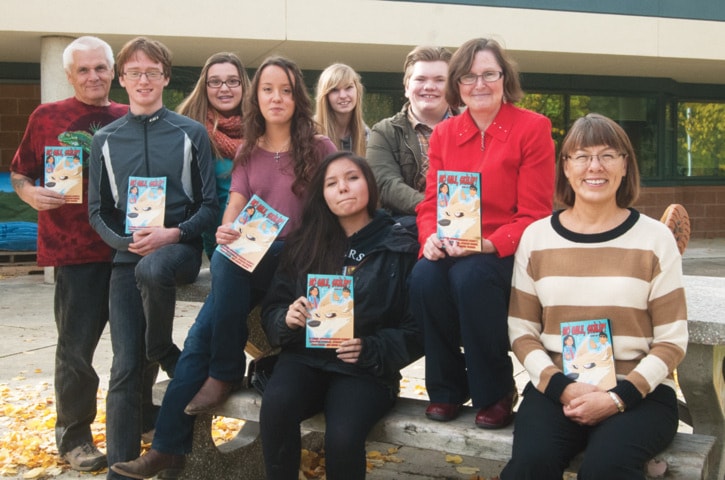Coyote the trickster tries his best, but he isn’t successful for long.
Six Salmon Arm Secondary students with aboriginal background have written a graphic novel intended for Grade 6 audiences in which Coyote figures prominently. It takes a stand against messages in the media intended to influence young people in negative ways.
Filled with bright, glossy pages, expertly drawn characters and a story line with a message, the short novel tackles the persuasiveness of product branding as well as the photoshopping of models and the effect on body image and self esteem.
Coyote does his best to persuade the two main characters in the story to buy into his products and his version of beauty, but they, instead, decide to think for themselves.
At a gathering at the SAS Sullivan campus Thursday, research coordinator Robin Wilmot from the University of Victoria presented the completed graphic novel entitled No Sale, Skèlèp! Skèlèp is the word for coyote in the Secwepemc/Shuswap language (Secwepemctsin).
Wilmot spoke about how good it was to work with the students who are now in grades 10 through 12.
“It was our total pleasure to work with all of you – you are amazing young people.”
The students seemed equally pleased to have participated in the creative process.
“I’d say it was a wonderful experience,” remarked Maria Thomas. “Something I’d look forward to in the future perhaps if the opportunity ever presented itself.”
Student Alexander Corbett was enthusiastic too.
“It was a whole lot of fun working together, learning a lot about the culture we didn’t know beforehand.”
The other four students who created the novel were Deanna Asham, Samantha Douglas, Spencer Rennie and Paige Rivers.
Christian Ryan did the illustrations.
Wilmot expressed appreciation to others who contributed including: Irene LaBoucane, district principal of aboriginal education; elder Virginia Woolridge who opened and blessed each session; John Sayer and Chelsea Prince who provided cultural guidance; Craig Adams; Meredith Rusk; Annie Williams and more.
The graphic novel was funded by the Canadian Institute of Health Research as part of a goal of spreading ‘media health’ messages to indigenous adolescents using culturally relevant material.
